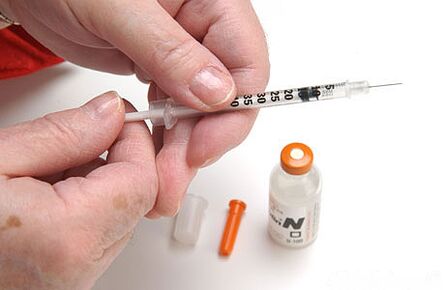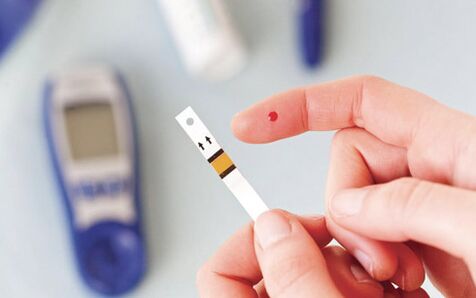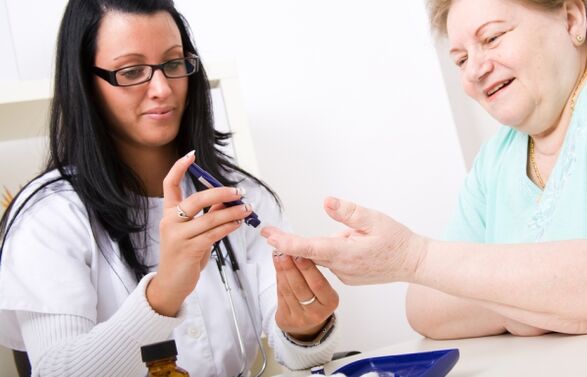Insulin - the secret of the processor hormone, playing an important role, ensuring the perseverance of blood glucose. Diabetes mellitus is a result of this hormone deficiency. The complications caused by this disease often cause death. The basic principles of diabetes treatment are strict adherence to diet, take drugs or insulin injections, track blood glucose levels, observe your body so as not to release the first signs of complications.

The pathogenesis of disease
Diabetes mellitus is a continuous violation of insulin hormone synthesis and interaction with tissues in the body.
Insulin processes sugars received into glucose and passes through the cell membrane. Therefore, hormones lower blood sugar levels and supply cells with nutrition. Insulin deficiency with affected tissue sensitivity leads to the fact that glucose does not participate in metabolism and continues to circulate through the body. Biology is not only the metabolism of carbohydrates is lost, but also fat, protein, water salt.
The rise of sugar increases the amount of lipid breakdown in the bloodstream, which contributes to the development of atherosclerosis. The transformation of glucose to glycogen slows down, and the body begins to use fat as a source. Fatty acids break down and ketone body appears to cause damage to the central nervous system.
Reason and current
Insulin production is disrupted due to the damage to beta cells synthesizing. The main risk factor for diabetes is hereditary, which improves the effects of other factors. The probability of getting sick with age. Causes of diabetes:
- Failure of the immune system. Causes cell attacks with pancreas with protective protein.
- Obesity. Reduces receptor reaction to hormones due to excess adipose tissue (cause of diabetes type).
- Pancreatic disease. Call the death of cells that hide hormones (pancreatitis, cancer).
- Viral infections (chickenpox pathogens, rubella, influenza).
- Nervous tension.
The disease exists in the role of free pathology and as a temporary symptom. Causes of diabetes mellitus may be due to endocrine organs (hypertension, pheochromocytoma). The advantages of symptomatic glucose detected during pregnancy (including using IVF) are called gestational diabetes. Hyperglycemia occurs as a side effect of prolonged use of drugs (glucocorticoids, estrogen, psychotropic drugs), when exposed to toxic substances.
Hyperglycemia marks diabetes only in the presence of insulin error, the appearance of symptoms of sugar disease.
The type of diabetes pathology

Diabetes mellitus is a violation of carbohydrates and metabolism in the body.
WHO Classification determines two main types of diseases: insulin -depending on me (I type) and the opposite form -Insulin -dependent diabetes (type II). They are different from the causes of appearance and details of pathogenesis, the nature of the course, have their own features of treatment, but the consequences are dangerous.
- Insulin -dependent (juvenile) diabetes is caused by autoimmune invasion. The affected endocrine beta cells cannot produce insulin in the required dose, its continuous administration from the outside is required. People under the age of 30, are thin. The disease begins suddenly, quickly develops and has severe courses.
- Insulinone -depending on. The cause of this type of diabetes is hereditary and obesity. Insulin can be produced in sufficient quantities, but cells are not sensitive to it. This is due to excess nutrients. Patients with diabetes over 40, have a complete body. The diabetes obtained gradually develops, continued stable. Most patients experience this type of disease.
X
The severity of the development of diabetes mellitus in the glycemia, glucosuria, target organ dysfunction, the presence of complications is determined, which indicates the ability of the body. There are 4 degrees of severity. If diabetes passes to a light level, then treatment and nutrition are selected correctly. The level of diabetes and symptoms are described in the table.
| Degree | Blood sugar, mmol/l | Urine readings | Symptom |
|---|---|---|---|
| First (light) | No more than 7 | Protein is normal, glucosuria is absent | Absent |
| 2 (middle) | 7-10 | Glucose up to 40 g/l; Ketosis and ketoacidosis appear regularly | Damage to cardiac activity, visual tools, nervous system, angioneropathy manifestations |
| 3 (heavy) | 10-14 | Continuous glucosuria 40 g/l, lots of protein, body ketone | Improved effects on organ, falling vision, pain and numbness in the legs, increased blood pressure |
| To -4 (superpolate) | 15-25 | More than 50 g/l of glucose, intense proteinuria and ketoasidosis | Strong defeat of all organs, kidney failure, diabetes, gangrene, ulcerative focus on the foot |
Symptoms of a characteristic diabetes

The clinical signs of the disease in most cases are characterized by a gradual course.
Diabetes in adults may not immediately declare themselves that it leads to the development of complications. Type I diabetes develops rapidly with high glycemia and coma. The intensity of the symptoms of diabetes obtained is associated with the level of lack of insulin products, the personality of the patient's body. You need to undergo a test to determine the level of blood sweetness, if one of the symptoms appears:
- Extraordinary sensation of dry mouth;
- inability to eliminate thirst;
- Increased diuresis - an increase in the amount of urine displayed;
- rapid weight loss or weight gain;
- itching and dry skin;
- reduce skin sensitivity;
- numbness, tingling in the feet and arms;
- seizures, severity in the feet;
- Purulent skin processes caused by slow skin regeneration;
- low resistance to infection;
- constant feelings of hunger;
- vague vision;
- increased blood pressure;
- swelling of the face and feet;
- Headache, fainting;
- Odor of body acetone;
- darkness of consciousness;
- pseudo -peritritin (fake "sharp stomach").
As a result of glycemia
Diabetes mellitus is a dangerous disease. Advantages of blood sugar harm the blood vessels, causing damage to the wall. Excess glucose is transformed into fat deposits. This leads to obesity and steatogepatosis (lipid accumulation in hepatic cells). Glucose causes glycolization of membrane protein. The oxidative process can cause protein function to be affected and toxic appearance by -product. Defective proteins cause disruption in organ structure. The accumulation of toxins and ketones causes damage to the patient's nervous system, leading to disruption in the mind and coma. Excessive blood cholesterol settles on the artery walls of damaged areas and form atherosclerosis plaque, contributing to eye angiopathy, vessels and other organs.
Advantages of blood glucose levels determine the complexity of the disease.
The risk of complications

Complicated diabetes mellitus brings the danger of the life of a sick person, so it is very important to identify the disease over time and start treatment. The disease is aggravated for 10-15 years. Complications that appear quickly and are not easy to overcome. Acute complications with primary diabetes (hypo- and hyperglycemia) are caused by sharp fluctuations in blood sugar. A list of states that complicate diabetes patients:
- Hypoglycemia - a sharp decrease in glucose less than 3 mmol/l can lead to hypoglycemic coma.
- Hyperglycemia - lifting a sugar indicator above 6 mmol/l ending with a hyperglycemic coma.
- Ketoacidosis - damage to neurons with ketone body, causing a person.
- Neuropathy - damage to edge nerves.
- Diabetes, trophic ulcer and lower deadline caused by angiopathy and neuropathy.
- Nephropathy - damage to small capillaries of the kidneys, which interferes with the function of the urinary system.
- Retinopathy - thinning of retina vascular wall.
- Cardiomyopathy - a disorder in the heart muscle.
- Encephalopathy - pathology in the cerebral vessel.
Diagnostics
Diagnosis of diabetes determines the type of disease, severity, the presence of internal organs. Studies can be conducted repeatedly to assess the level of disease progress and the effects of treatment. Diagnostic criteria for diabetes are signs of diabetes and level of glucose lifting. To confirm the diagnosis, urine and blood tests, instrumental studies are performed:
- glucose indications on an empty stomach;
- glycemic profile (daily vibration);
- blood at insulin level;
- studies of glucose tolerance, ratio of sugar on empty stomach and after carbohydrate use;
- analysis for glycolation hemoglobin;
- blood for biochemistry;
- General urine analysis detects glucose, protein;
- electrolyte blood tests;
- indication of acetone in urine;
- Eye examination;
- Rebel tests for kidney damage;
- Abdominal ultrasound;
- cardiogram to check heart function;
- Capillaryoscopy, lower leg reuroscopy determines the level of defect in the vessel.
In healthy people, blood glucose levels are within 3. 3-5. 5 mmol/l.
Disease

In the presence of suspicion of diabetes mellitus, this diagnosis must be confirmed or denied.
Diabetes mellitus is a chronic pathology that needs to be treated for life.
The principle of diabetes treatment - sugar control in blood flow glucometers and prevention of complications by observing diet and taking medication.
Endocrinologists can treat the disease, cardiologist, neuropathologist, eye specialist, vascular surgeon connected.
Modern treatment methods - medicines, diet, physical education - slow down the development of the disease.
Medication
The doctor chooses the medicine, given the type of disease. Type 1 diabetes mellitus requires only insulin therapy, type 2 diabetes can be treated with sugar. The tablet acts on the pancreas, increasing the sensitivity of the peripheral tissue. The drug is used:
- Sulfanilamides.
- Biguanides.
- Preparation of short and prolonged action insulin. Insulin is easily given 3-5 times a day, and long insulin up to 2 doses. Maybe a combination of drug use.
Diet with diabetes
Diabetes treatment certainly includes a diet with a selection of calorie content, excluding carbohydrates easily digested, sugar. Diabetes requires fractional power. At the same time, the ratio of nutrients remains close to physiology. Sugar is replaced by xylitol or sorbitol. In the form of middle and severe illness, Diet No. 9 Recommended. It is allowed to eat vegetable soup, low-fat fish and meat, sour milk and cheese products, cereals (buckwheat, barley oats), fruits, sweet and sour taste. You cannot eat sdoba, sugar -gula, fatty dishes, rice semolina, pasta, grapes, salted, marinated vegetables.
Prevention
The occurrence of type 1 disease cannot always be affected, as it can trigger viral pathogens. Because type 2 diabetes development is considered an unhealthy lifestyle, especially in people with a prerequisite of heredity. Steps -Preventive Steps If sugar disease is diagnosed: proper nutrition in small portions with minimal carbohydrates and fats, maintaining optimal weight. Hypertension is also carried out by controlling blood pressure numbers. Periodically, you need to donate blood for glucose and lipid blood breakdown content. Moderate physical activity will help keep the body in tone.























